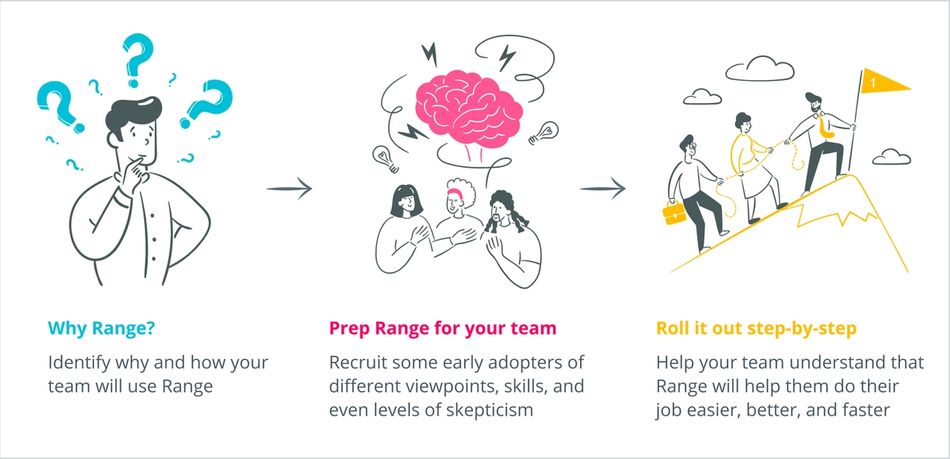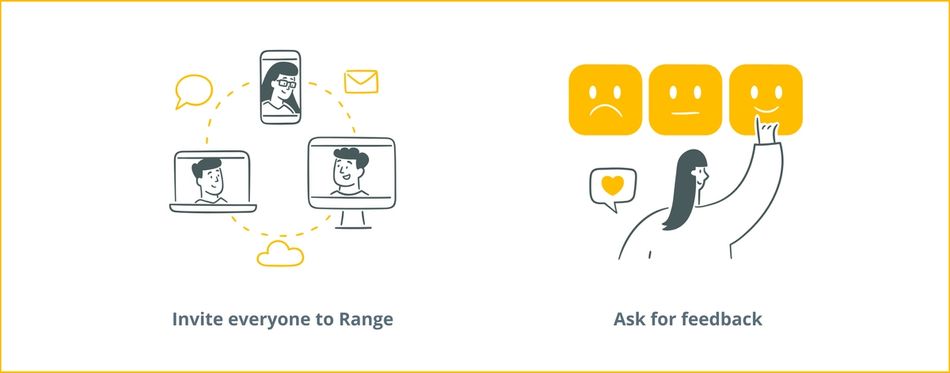
Welcome! Range helps teams all over the world to stay in sync, focused, and connected. There’s a lot you and your team can achieve with Range, and this guide has the best practices and tips to help your team get started and be successful on Range.
Your first step is a bit of planning. You’ll spend a half-hour identifying your goals and vision for using Range — how and why will you and your team use it?
Next, you and your early-adopters will spend a few days exploring Range and experimenting with its features. This takes just 5 minutes a day.
And finally, you’ll take a few minutes to share Range with your team. From there, you’re all set! You and your team will be ready to share Check-ins, and everyone will know what each other is doing, feel more connected, and achieve their goals.
Ready to get started? Let’s jump in.
Psst! Looking to just explore before inviting your team? Check out this getting started guide instead.
Identify why and how you want to use Range (30 minutes)

This section will walk you through identifying why and how your team will use Range. It’ll take just thirty minutes, so the next time you have an awkward half-hour between meetings, do your future self a favor and follow these steps.
As you walk through these steps, you can make a copy of our Range Onboarding Workbook to keep track of your answers and to see extra examples.
Part 1: Why you want to use Range (15 minutes)
Before you ask your team to start using Range, it always helps to be clear on why you’d like to make a change. Without a compelling reason, it’s easy for the team to forget or think of Range as just another tool.
Start with where you want to be. What goals will Range help your team achieve? How will Range improve your teamwork? What potential will be unlocked when your team uses Range?
To help, consider what’s not working — why do you feel a need to add Range? Some common pain points that drive teams to use Range are:
- Spending too much time in team meetings or 1:1s
- Feeling like you’re micromanaging your team
- Feeling lonely or disconnected from other teammates
Write down the problems or pain points that you see. Try to get specific with examples, like “Three teammates have mentioned feeling burned out in the last two weeks.” or “I’ve got ten weekly 1:1s to check in on status, and it’s hard to get work done.”
Next, consider how Range is going to help you solve that problem and how it will help the team. What will Range make easier for the team? What will Range replace? Consider things from both a team perspective and a teammate one — for a teammate, Range might help them get back more focus time in their day whereas, for the team, it might help keep everyone in sync so work moves faster. For example:
- Spending too much time in team meetings or 1:1s
- → Range replaces status meetings with async Check-ins.
- Feeling like you’re micromanaging your team
- → With Check-ins, the whole team shares updates with one another, and teammates can easily comment on Check-ins to ask for more context.
- Feeling lonely or disconnected from one another
- → Check-ins include a team-building component that helps us build trust and connection even outside the office.
Strong leaders are strong communicators. With these questions answered, you can create a simple statement of “Why Range” that will make it easy to communicate that with your team, helping reduce confusion and focus on getting folks started.
To help you brainstorm, check out the Range Onboarding Workbook.
Part 2: How you want to use Range (15 minutes)
Now that you know what you want to achieve, the next step is to set some guidelines for how you want the team to use Range. This step is important because it helps make it easy for your team to know what to do, and it helps you get the most out of Range to achieve your goals.
Most teams use Range to run async standups or status meetings. Others may share Check-ins as preparation for a team meeting, reviewing some items together over video. Part 1 should help you establish the goal for your team.
From there, you’ll want to answer a few questions:
- When should the team share Check-ins?
- E.g., Once a day or twice a week
- What should they include?
- E.g., their top 2-3 priorities for the day plus the top 2-3 things they accomplished yesterday. They should flag items where they need help.
- How will you consume/read the Check-ins?
- E.g., we’ll read them in Slack and review flagged items in our team meeting
To answer these questions, keep your goal in mind. If you’re trying to replace a daily standup, you’ll likely want to ask the team to share a Check-in every day. On the other hand, if you’re using Check-ins as pre-reading for team meetings, you may ask the team to just share a Check-in at least twice a week. For pre-reading, it may be extra important to ask folks to use a feature like Flags to highlight when they’re blocked or need help.
Refer to the Onboarding Workbook for additional examples and help in thinking through this process. Once you’ve got that process in mind, you’ll start recruiting a few early adopters to explore Range and role model the process you just outlined.
Preparing Range for your team (15 minutes)

Range is a team product, designed and built for teams to share and connect. That’s why you’ll want to recruit a small set of early adopters (or just grab a few friends) to help explore the product, test out a new process, and share learnings with the rest of the team.
Part 1: Recruit some early adopters (5 minutes)
We recommend recruiting a cross-section of different viewpoints, skills, and even levels of skepticism. And while we’ve got a few ideas for the best people to ask, don’t overthink it—if you have a few friends or fellow leads on the team, just ask for their help. If you want to be a little more analytical, consider asking:
- The Tools Lover: You know that one tech-savvy teammate who is always excited about the latest and greatest tool? They’re a great person because they’ll bring enthusiasm to explore everything Range can do. Ask them to try out some of the different features, even if you don’t plan to use them all.
- The Process Person: This teammate knows the ins and outs of the process you’re trying to optimize like the back of their hand. They might be a project manager or a tech lead, but whatever their role, they know how things work today, the challenges, and the constraints you’ll need to work within. Ask this person to create guidelines for how and when the team should use Range, and don’t forget to consider how Range will connect with your other tools and processes.
- The Insightful Skeptic: The fact is, some members of your team will be reluctant to make the move to Range. It might be someone who is a leader for another team and doesn’t understand the value of Range yet, or it might be the curmudgeon teammate who just doesn’t like new tools. Either way, skeptics often have great insights about the problems that change can bring. Inviting the skeptic to be an early adopter helps turn their criticism into insight. Ask them to identify any concerns and how to mitigate them, making them feel a part of the solution. When everyone knows that even that person is on board, they’ll be more comfortable joining, too.
When you’re ready to ask your teammates for their help, be candid about what you’re hoping to achieve. Share your “Why Range” and explain that you want to make sure Range is the right product for your team. Ask for their help — research shows asking someone for help is a great way to connect.
The Range Onboarding Workbook has a few questions to guide you through this and a template for emailing your early adopters.
Part 2: Explore the product (5 minutes a day)
You’ve already figured out how you want the team to use Range. And now it’s time to explore the product itself. Ask your early adopters to spend 5 minutes each day for the next 1-2 days in Range. Ask them to share a Check-in each day following your guidelines from earlier. We find teams do the best when the early adopters have shared at least two Check-ins before the rest of the team joins, but if you’d like to have them test it out for longer — a week or more, that works too.
Here are a few things to remember as you explore and share Check-ins. Check these off as you go in the Onboarding Workbook.
Create a team in Range
If you're at a larger organization or just want to keep your team neatly separated from other groups, the first step is to create your team. Teams help keep your work organized, so you see Check-ins from the right people. When you’re creating a team, make sure you add your adoption squad, so you’re all in the right place.
Range teams are most useful when they're structured around projects or workstreams, not job titles. Teams should reflect how your group gets things done and include all the folks who help make that happen.
Share a few Check-Ins
Experts say it takes three days to establish a habit. That’s why we recommend that you practice sharing a Check-in for at least a few days as you get started.
Doing so will not only make your team's workspace feel more lived-in and useful once your team arrives, but it will serve as a useful example of Check-in best practices. So make sure you model using all the features of Check-ins from integrations to flags to team questions, that way the team will follow suit.
This helpful guide shares everything you need to know about writing a great Check-in, so check it out now and get started.
Add Range to Slack or Microsoft Teams
Your team likely spends a lot of time in Slack or Microsoft Teams. And by adding Range to your communication tool, you can easily share Check-ins where your team is already working.
We recommend getting Range set up in your team's Slack instance before inviting them to start using Range. Seeing the early adopters’ Check-ins will help folks start to learn about and be curious about Range, plus it will make it easier for them to start sharing Check-ins too.
Check out more about how to link Slack to Range here.
Simplify Check-ins with Apps
One of the best things about Range is that it brings all of your work together in one place, making it easy to plan your day (without opening 15 tabs). Plus, adding apps let you add context for your colleagues about your daily work and schedule.
For example, you could:
- Alert your team that you’ll be OOO from 1-4 pm by embedding a read-only version of your Google Calendar
- Tell your developers you’re be doing a code review and want their feedback in GitHub
- Fill other team leads in on your project progress with a list of your completed Asana tasks.
You can learn about all of Range's apps here, along with info on how to implement them. If you need more help, we recommend partnering with your IT team to get started.
Incorporate learnings
As your early adopters use Range, you may run into some kinks with your intended process. Make sure to adjust the process based on these learnings. And if it’s a problem with Range, just let us know, and we’ll try to fix it as soon as we can.
Once your process is feeling good with these first few folks, you’re ready for the final step — sharing Range with everyone on the team!
Share Range with your whole team (15 minutes)
Now that you’ve done all the prep work, it’s time to invite your team to Range!
You’ll want to spend a little time on the communication — sharing context over email and in a team meeting. First impressions matter, so be sure to communicate your “why” to the team just as clearly as you did to your early adopters. You want everyone to understand that Range will help them do their job easier, better, and faster — it’s not just another box to check.
Beyond the why, you’ll want to be clear about the specific guidelines, and make sure to share tips that you and the other early adopters learned along the way.
You can use your Onboarding Workbook to adapt the template team email and talking points. Make sure to share this getting started guide with the team, so they have all the information about Range too.
Let your team know that you’ll be regularly checking back in and asking for their feedback; you’re all in this together.
Circle back for feedback

Range is all about keeping your team connected and making sure everyone gets the help they need. A big part of that is gathering and sharing feedback.
To ensure your team is getting the greatest value out of Range, you'll want to check back in regularly and see how their experience is going. Are they feeling supported? Is it saving them time?
Make sure your most-used integrations are linked across the entire team and take a moment to verify that people are reading, commenting, and adding emoji reactions to one another’s Check-ins. Engagement matters, and it makes all the difference in your Range experience.
The Range Help Center has resources to help you get the most out of Range, and we’re always adding new articles to our blog, from tips on developing great cultures to setting OKRs and managing remote teams.

